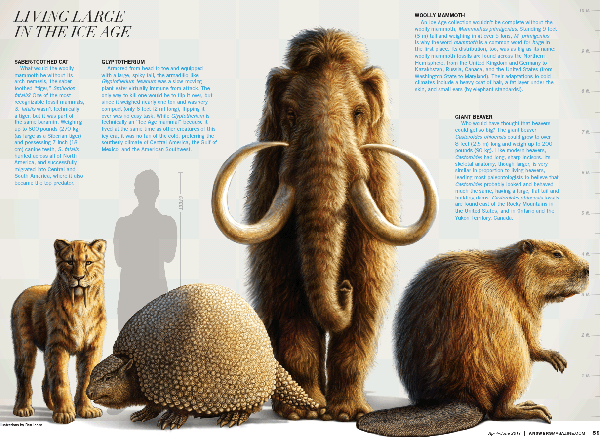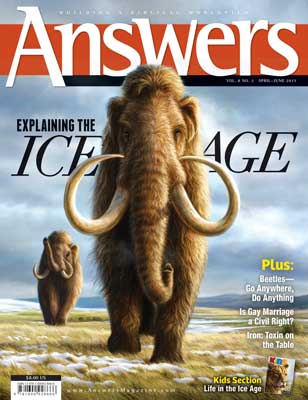Why Were Ice Age Animals So Big?
Big critters like the giant sloth and woolly mammoth dominated during the Ice Age. What made their size useful? What do the fossils tell us? What happened to them?
When you think of the Ice Age, you think of big critters like the woolly mammoth and giant beaver. Why was this huge size so helpful?
Ice Age animals, especially the large mammals, seem to have won a special place in people’s hearts. While plenty of other strange and wonderful fossils inhabit museums, let’s face facts: nobody makes children’s movies or television shows about armored fish or extinct sea-scorpions. On the other hand, mammoths, saber-toothed cats, and other giant mammals show up everywhere in popular culture. Just look at the success of the Ice Age animated movies. Fascination with Pleistocene megafauna (“big animals” of the Ice Age) is alive and well.
One reason for our fascination is that many familiar animals possessed unusual traits during the Ice Age (who put hair on those elephants?) or lived in unusual places (why did giant South American armadillos move to Texas?). The main interest, however, is that they were, well, big. Something about being big impresses us. An ordinary beaver: no big deal. But an eight-foot-long beaver: now that’s impressive!
Rules, Rules, Rules
Unlike physics and chemistry, biology has relatively few mathematical rules or “laws.” And the handful of useful equations (such as those in population genetics) rarely apply to real-world situations. Why? Unlike molecules or falling bowling balls, living creatures don’t often follow simple rules. They are dynamic and unpredictable.
Cope’s Rule
Although biology is often too complicated for us to understand why many things are the way they are, biologists have identified some patterns. A couple of these patterns relate to the size of Ice Age organisms. The first is Cope’s rule, named after the famous nineteenth-century paleontologist Edward Drinker Cope. Studying mammal fossils from North America, Cope noticed that within similar kinds of animals (such as the dog or deer families), the fossil species found in the lower layers were often smaller than the species found higher up. Since the Ice Age layers are high up, Ice Age layers often contain larger species. But why is Cope’s rule true? Scientists don’t know for sure.
Because Cope was an evolutionist, he thought some unknown principle of evolution produced larger organisms with time. Although creationists disagree with Cope’s understanding of evolution, the trend from small to big might still apply to the “kinds” (baramins) of animals that left Noah’s Ark after the Flood. The big Ice Age mammals are not new kinds of creatures but merely larger variations within the original kinds that God created on Day Six of Creation Week.
We know that each land-dwelling baramin was represented on Noah’s Ark (Genesis 6:19–20). Since God desired these Ark-saved kinds to “be fruitful and multiply on the earth” (Genesis 8:17), perhaps the size increase occurred within the baramins as the animals left the mountains of Ararat and multiplied to fill the earth.
Among many mammal kinds, Cope’s rule fits the pattern: many of the earliest post-Flood mammals were small, but their descendants were often much larger, including rhinos, deer, cats, and even some rodents, like beavers.
It turns out that being bigger has lots of advantages.
But why should mammal lineages get bigger over time? It turns out that being bigger has lots of advantages. While bigger mammals need more food than smaller ones, bigger mammals don’t need as much food per pound.1 Moreover, bigger versions can move faster than their smaller comrades, and perhaps they are better at intimidating predators or escaping from them. And interestingly, larger animals usually live longer than smaller ones.
So in choosing small animals to go on the Ark, God satisfied several needs at once. Small animals take up less space and eat less. This would reduce the stress on Noah and his family. In the barren years after the Flood, smaller animals could also make do with less food, find shelter more easily, and generally reproduce more quickly.
At the same time, God wisely chose small animals that would be able to produce larger members of their kinds over time. As earth rebounded from the effects of the Flood (the climate stabilized, etc.), this variety of sizes would help post-Flood animals adapt to changing conditions. As food became more plentiful and temperatures cooled, these larger descendants could take advantage of the new conditions.
Bergmann’s Rule
The second “rule” may apply to the specific climate conditions of the Ice Age itself. The nineteenth-century German biologist Carl Bergmann noticed that species tend to be larger in colder climates than similar species of the same genus living in warm climates. This makes sense because a larger body retains heat more efficiently. As an animal’s total size increases, its surface area increases, but not as quickly as its volume.
Think about hot water in a water balloon. A little water makes the balloon expand a lot, but it doesn’t stay warm very long because so much surface area is exposed to the air. If you keep filling the balloon, the water will stay hot much longer because the surface area does not grow as fast as the volume of water. In the same way, a large animal stays warmer because a smaller proportion of its surface area is exposed to the air.
While this trend is recognized among species of living mammals and birds, Bergmann’s rule can also be used to compare species within the same baramin living at different times. They would tend to be larger as the weather became cooler. In other words, many mammals were already increasing in size after the Flood (Cope’s rule), but some animals could also have increased in size as a direct response to dropping temperatures (Bergmann’s rule).
Which Rule Rules?
These two biological principles explain at least part of our Creator’s designs for mammals to vary. Depending on the mammal kind being studied, either rule could explain the large size, or both rules might have operated at the same time. It is also likely that other forces, still unknown to scientists, affected the animals after the Flood, so lots of work is still left to be done!
As paleontologists look into the fossil record of the big Ice Age mammals, they may be able to tease out some of the rules at work. On the one hand, some animals, such as the giant ground sloth Megalonyx2 and the armored Glyptotherium, got big far from cooling temperatures. So Cope’s rule is a strong contender.
On the other hand, some animals had specific adaptations for the cold that are not seen in most other creatures of their baramin. Two examples are the large body size of the saber-tooth cat Smilodon (who possessed a stocky body and short but powerful limbs3) and the woolly mammoth’s large size and many cold-deterring features (see sidebar). Both of these animals are good candidates for Bergmann’s rule.
The “Big” Picture
So when it comes to understanding the animals of the Ice Age, it’s an interesting mix. While some animals appear to have gotten larger because of abundant available resources and the efficiency of size (Cope’s rule), as temperatures dropped after the Flood, bigness had additional advantages, such as better heat retention (Bergmann’s rule). And there are certainly other, as yet undiscovered, factors involved as well. What is truly amazing is that our wise and loving Creator foreknew all these needs and equipped each kind with the ability to adapt and thrive in the constantly changing post-Flood world.
Mystery of the Megafauna Extinction
One of the most perplexing issues about the Ice Age megafauna (“large animals”) is their sudden extinction only a few thousand years ago, as the Ice Age ended. While many theories have been proposed, the most likely culprits are hunting by humans and rapid climate change.
Especially in North America, the extinction of about two-thirds of the megafauna species coincides with the immigration of humans, who apparently crossed a land bridge that connected Siberia and Alaska, and made their way south throughout both American continents. These first immigrants were accomplished hunters who fashioned distinctive stone tools and weapons. They spread quickly throughout the continents about the same time as the end of the mammoths, saber-toothed cats, camels, horses, glyptodonts, and dozens of other large mammals. Only a few large mammal species, such as bison, elk, deer, wolves, and cougars remain today.
While humans may have been primary agents of extinction, it is still uncertain that they could have wiped out so many different species. Perhaps the rapidly changing climate as the ice sheets retreated, or the loss of key carnivore or herbivore groups (or even loss of some plants), resulted in catastrophic ecological imbalances.
Answers Magazine
April – June 2013
What unique conditions were required to start the Ice Age, and where does it fit in Bible times? Why did Ice Age animals grow so big, and what happened to them? Also, can you explain why God made more species of beetles than any other animal? Can you prove that Genesis 1–3 is not a Near Eastern myth? Read the answers to these questions and many, many more in this issue!
Browse IssueFootnotes
- For example, while an elephant eats much more than a mouse, an elephant uses less energy per pound to stay alive. Also, an elephant’s heart rate is much slower than a mouse’s, and elephants use much less energy to keep their body warm because their huge volume helps insulate them from heat loss. Because of this, larger animals can afford to have a slower metabolism than smaller ones.
- See “Megalonyx—Gentle Giant of the Ice Age,” pp. 22–25.
- This example may actually follow what is known as Allen’s rule: animals in colder environments tend to have shorter limbs than those in warmer environments.
Recommended Resources

Answers in Genesis is an apologetics ministry, dedicated to helping Christians defend their faith and proclaim the good news of Jesus Christ.
- Customer Service 800.778.3390
- Available Monday–Friday | 9 AM–5 PM ET
- © 2025 Answers in Genesis





